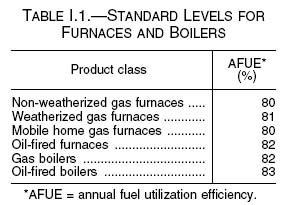
While the change
in standards underscores the Department’s commitment to meeting its aggressive
five-year appliance standard rulemaking schedule, a coalition of consumer,
energy and environmental organizations have sharply criticized the DOE for
“extraordinarily weak” standards that have changed little from the original levels
set by Congress 20 years ago.

“A 90 percent natural gas furnace efficiency standard would provide more than 17 times the carbon savings," said David B. Goldstein, Energy Program Co-Director of the Natural Resources Defense Council in a statement.
The coalition also points out
that 99
percent of natural gas furnaces currently sold already meet the new minimum
efficiency level.
“Our country cannot create a sustainable
energy and climate future through incrementalism," stated Kateri Callahan,
President of the Alliance to Save Energy.

It seems the DOE itself acknowledges that higher standards could have been considered. But since this Final Rule for residential furnaces and boilers was issued under a consent decree schedule ― and time ran out ― the Department went forth and issued the Nov. 19 Final Rule.
DOE wanted to address natural gas price impacts as a result of the standards, but request for more time was denied. “DOE wished to more fully consider such potential impacts, prior to finalizing this Rule, and preliminarily believed that, if confirmed, would have merited consideration in evaluating higher efficiency standards for the products covered by this rulemaking,” said the DOE in its announcement.
However, there could be a “do-over” for residential boilers. Congress may override the new DOE standards with a multipart standard agreed to by manufacturers and efficiency groups last year. It contains the same efficiency ratings set by DOE, but doubles savings by disallowing standing pilots and requiring controls that cut energy use by up to 10 percent.